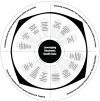A Taxonomy for Health Information Systems
- PMID: 38820575
- PMCID: PMC11179026
- DOI: 10.2196/47682
A Taxonomy for Health Information Systems
Abstract
The health sector is highly digitized, which is enabling the collection of vast quantities of electronic data about health and well-being. These data are collected by a diverse array of information and communication technologies, including systems used by health care organizations, consumer and community sources such as information collected on the web, and passively collected data from technologies such as wearables and devices. Understanding the breadth of IT that collect these data and how it can be actioned is a challenge for the significant portion of the digital health workforce that interact with health data as part of their duties but are not for informatics experts. This viewpoint aims to present a taxonomy categorizing common information and communication technologies that collect electronic data. An initial classification of key information systems collecting electronic health data was undertaken via a rapid review of the literature. Subsequently, a purposeful search of the scholarly and gray literature was undertaken to extract key information about the systems within each category to generate definitions of the systems and describe the strengths and limitations of these systems.
Keywords: actionable data; data revolution; digital health; eHealth; electronic health data; mobile phone.
©Anna Janssen, Candice Donnelly, Tim Shaw. Originally published in the Journal of Medical Internet Research (https://www.jmir.org), 31.05.2024.
Conflict of interest statement
Conflicts of Interest: None declared.
Figures
References
-
- Kitchin B. The Data Revolution: Big Data, Open Data, Data Infrastructures and Their Consequences. Thousand Oaks, CA: SAGE Publications; 2014.
-
- Bhambere S, Abhishek B. Sumit H Rapid digitization of healthcare - a review of COVID-19 impact on our health systems. Int J All Res Educ Sci Method. 2021;9(2):1457–9.
-
- Vargo D, Zhu L, Benwell B, Yan Z. Digital technology use during COVID-19 pandemic: a rapid review. Human Behav Emerg Technol. 2020 Dec 28;3(1):13–24. doi: 10.1002/hbe2.242. - DOI
-
- McKay FH, Wright A, Shill J, Stephens H, Uccellini M. Using health and well-being apps for behavior change: a systematic search and rating of apps. JMIR Mhealth Uhealth. 2019 Jul 04;7(7):e11926. doi: 10.2196/11926. https://mhealth.jmir.org/2019/7/e11926/ v7i7e11926 - DOI - PMC - PubMed
Publication types
MeSH terms
LinkOut - more resources
Full Text Sources



